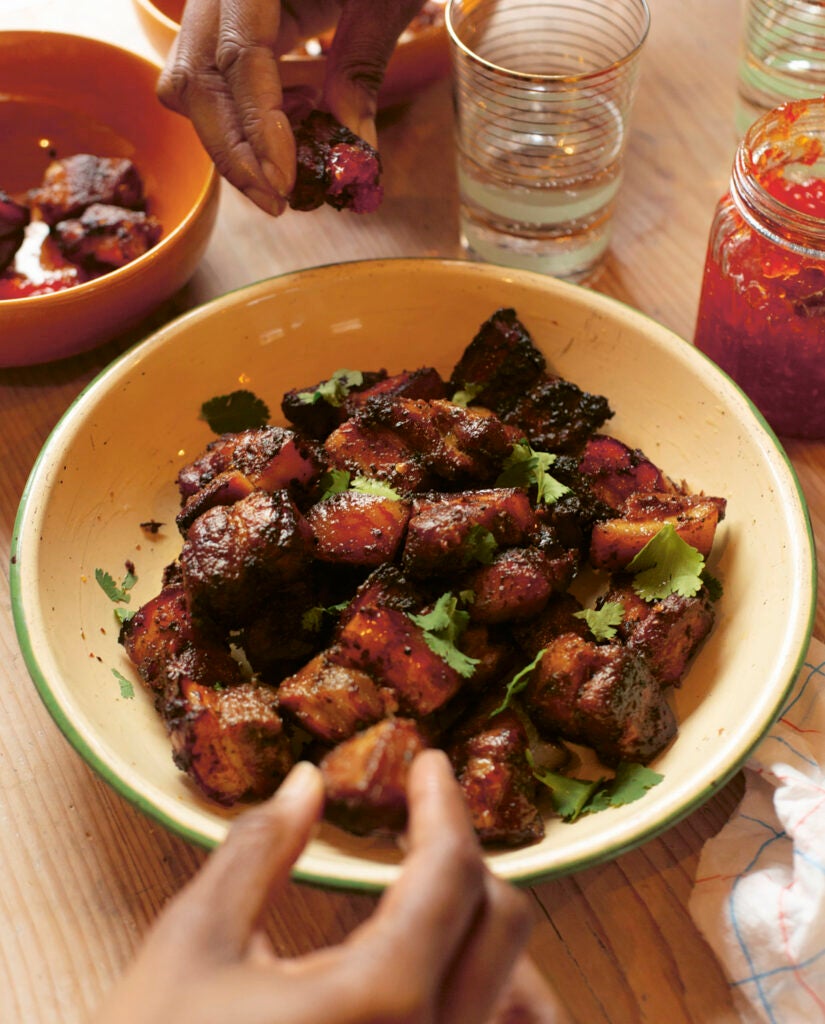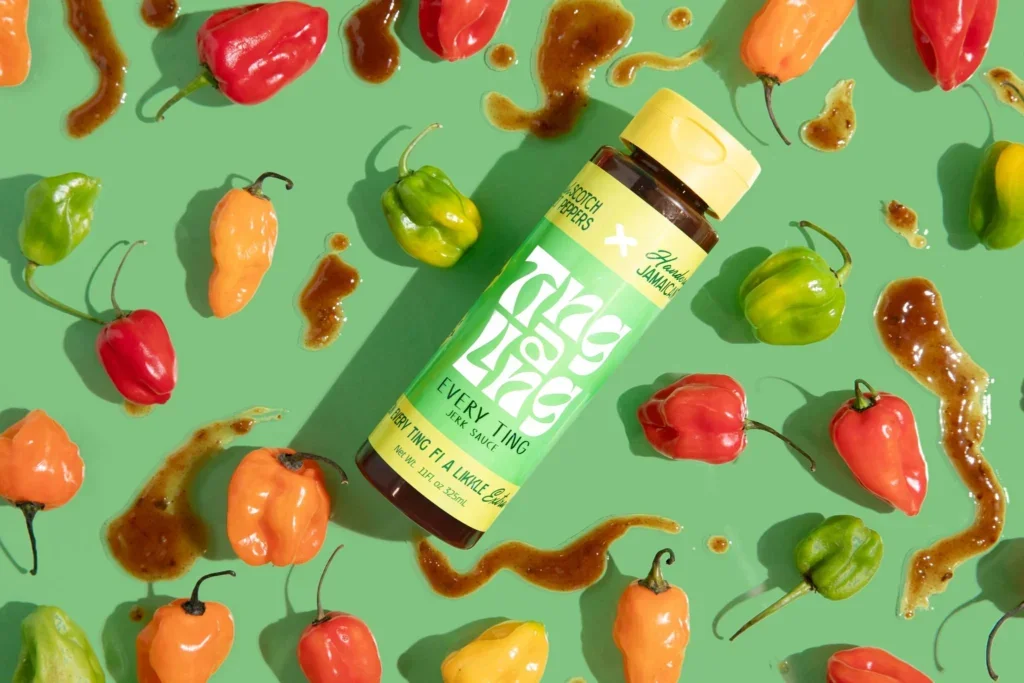
Jerk is everywhere these days, but what does it mean for the proliferation of Caribbean food?
A few weeks ago, on the walk home from my post office in Flatbush, Brooklyn, I noticed a neighborhood fast-food halal chain, Halal Bros Grill, advertising its newest menu items: loaded jerk chicken fries, jerk chicken over rice, and a jerk chicken quesadilla. Living in Brooklyn’s Little Caribbean neighborhood, I’ve eaten jerk-flavored patties from Tastee Pattee, Guyanese jerk pork lo mein from De Bamboo Express, and hundreds of cumulative pounds of charred allspice-scented jerk chicken from Fisherman’s Cove and Peppa’s. I’ve breathed in lungfuls of smoke while waiting to order from the sidewalk vendor who sets up a barrel grill at my corner for a few months every summer.
But in the last year or so, I’ve seen jerk transform from a grilling technique that permeates meat with smoke, allspice, and Scotch bonnet pepper into a fluid descriptor that’s been applied to dumplings, rum cocktails, ice cream, and even fast-food quesadillas.
In the last year or so, I’ve walked by snaking lines for jerk pizza, stood in a queue for a sold-out jerk chicken salad sandwich on coco bread from a popup by baker Bryan Ford, and watched viral videos of the rapper Rubi Rose assisting in the construction of a bodega jerk chopped cheese. It’s all made me wonder: What can’t jerk do? And how did this specific set of flavors become such a common cultural shorthand for Caribbean cuisine?
In her 2025 cookbook Kin, London-based author and chef Marie Mitchell includes recipes for jerk rub, marinade, and sauce. She uses these staples to season pork belly cubes, wings, lamb burgers, ital coconut stew, and canned jackfruit. In her book, Mitchell, whose parents are from Jamaica, points out that much of the English-speaking world conflates Jamaican food with Caribbean food, simply because Jamaica is the largest former British colony in the region.
“While it’s specifically Jamaican,” Mitchell writes, “jerk is an incredible example of the complexity and ingenuity of Caribbean cuisine in general, and of how the food is so richly expressive of the people.”
In the 17th century, as the British pried Jamaica away from Spanish colonists, many people who had been enslaved by the Spanish escaped into the Jamaican mountains to establish free communities of Maroons. The Maroons adapted some of the cooking techniques that had kept the indigenous Taíno people safe from the violence of the Spanish. This included smoking meat (such as wild boar) underground with pimento wood smoke so that the fires couldn’t be detected by colonists. Today the pimento flavor is often introduced by pimento berries (also known as allspice) in the marinade for the meat.
As London Chase, the chef at Brooklyn’s recently opened Mango Bay, points out, the salt and smoke of jerk has also been a resourceful way of prolonging ingredients’ shelf life throughout history. “We actually used it back in the day just to ferment and preserve certain types of food,” he says. “You could basically jerk and pickle anything.”
“It just doesn’t feel as if Caribbean food has had time to really be embedded and infiltrated.”
Growing up in French Guiana, Chase remembers using jerk sauce to ferment fruits and vegetables, turning grated mango into spicy achar that came in handy during periods when the government would shut off the electrical grid without warning. “You need to know how to preserve your food when the lights go off,” he says. At Mango Bay, Chase serves a jerk chicken Caesar salad, grilled octopus with jerk gremolata, and a burger with jerk aioli. See photo above for Chase’s octopus with jerk seasoning.
Over a jerk daiquiri (white rum, thyme, allspice, and habanero) and some patties at chef Paul Carmichael’s newly opened Caribbean restaurant Bar Kabawa in Manhattan, I asked Mitchell about what she thinks about jerk becoming such a popular buzzword for cultural mash-ups and viral menu items.
“I hate the idea that it needs to have this cultural movement, but I suppose for me, it just doesn’t feel as if Caribbean food has had time to really be embedded and infiltrated,” she says. “Jerk definitely is the thing, I suppose, that is penetrating, but I can find it frustrating that it’s become this kind of homogenized package, and it feels like the only thing that exists in terms of the lexicon of Caribbean food.”

In her cookbook Kin, author and chef Marie Mitchell includes recipes for jerk rub, marinade, and sauce, and uses the rub in her Naughty Pork Bites recipe. Photo: Christian Cassiel
For Mitchell, jerk’s meteoric rise to fame outside of the Caribbean is “a double-edged sword”—a gateway into learning about the Caribbean’s diverse food history, but also, at times, an oversimplification of that history. “It’s not that I don’t want it to be something that’s celebrated and spoken about,” she says. “But I think when it’s removed from context, without any connection to it, then it becomes something else.” Of course, anytime a particular dish picks up the momentum of virality, some context is liable to get lost along the way.
“It’s definitely become more commercialized,” says entrepreneur Shanice Black about jerk in recent years. Black and her mother founded Ting A Ling, a Brooklyn-based company that started selling bottled and jarred jerk sauces and marinades last year. Black says that she’s seen plenty of jerk missteps over the years, such as when someone labels a menu item as “jerk” while missing the intricate layers of allspice and Scotch bonnet or the cultural nuance that goes into the dish. She’s also encountered a lot of assumptions about what jerk can and can’t be used for.
“The biggest misconception is that it can only be used on chicken, and I think it’s such a diverse flavor profile that it really can be used on anything—like veggies or seafood,” she says. “A lot of people really only see it in this one-dimensional view.” Black was shocked by how much she liked jerk sauce on ice cream.
The wide availability of packaged jerk sauces and rubs (from both newer brands like Ting A Ling and long-standing grocery brands like Grace) makes the flavor profile a tempting muse for rogue experimentation. These bottled sauces make jerk rum raisin sundaes and chopped cheeses on croissants “the Ocky way” possible.
“Jerk has become synonymous with the Caribbean,” says Shelley Worrell, partially because it is “such an accessible mélange of flavors.” Worrell, who grew up between Brooklyn and the Caribbean, is the founder of caribBEING, a local Brooklyn cultural organization that amplifies Caribbean art, food, and businesses. “From rubs to marinades, you can literally add jerk to anything, even eggs—if you can afford them.”

This March, for the third year, New York chef and author JJ Johnson hosted a massive “Jerk Jam” at the Nassau Paradise Island Wine and Food Festival in the Bahamas. Hundreds of international tourists and Bahamians gathered in a sandy lot, flanked by smokers, grills, and prep tables handing out bite-size jerk creations. Johnson cooked crispy-skinned jerk snapper with corn-papaya salad and rice, and his cohost, chef and TV host Kardea Brown, made rasta pasta: ziti with bell peppers, shreds of chicken, and a jerk-flavored alfredo sauce.
“Jerk is the entry point to the Caribbean,” says Johnson, who grew up eating it at family cookouts in Queens. “Most people think of it as being from Jamaica, but it is a celebration of Caribbean culture. It’s the barbecue sauce of the Caribbean.”
Nassau chef Antonio Williams explains that jerk is as integral to the food of the Bahamas as it is to the food of Jamaica. “We equate jerk with grilling or barbecuing,” he says. For the Jerk Jam, he made jerk chicken duff (a steamed sweet Bahamian cake that’s usually topped with guava sauce) and jerk chicken corn dogs that drew a long, winding line to his tent. To achieve a crispy fried shell without drying out the jerk chicken inside, Williams smoked, shredded, and sauced the chicken first, freezing it into balls that would then be battered and fried on a skewer. He served his corn dogs with spicy mustard and a ketchup made with sweet, in-season mangoes.
At the festival, I ate jerk pig tails from Vell Monkey Foot, jerk chicken gyro from Tropical Gyros, jerk grouper siu mai from the Poop Deck, and jerk prawn spring rolls from Kitchen Culture—all local restaurants and catering businesses in Nassau. The only jerk I turned down over the course of the weekend was the jerk chicken sandwich from the Quiznos at the Nassau airport, which advertised toppings like mozzarella, lettuce, mayo, and barbecue sauce.
In an age of chaos cooking and internet virality, it might be tempting to get swept up in the spirit of all this innovation and to think of jerk as a free-for-all—a set of flavors that truly can be applied to any meat, fish, pasta, dessert, or drink. At Mango Bay, Chase has his own threshold for how much creative liberty is too much creative liberty.
“If your grandparents can’t come in as Caribbean people and eat your food and say, ‘This tastes like my mother’s cooking,’ then you shouldn’t be messing with it.”